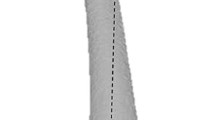Abstract
The bony geometry of the distal femoral condyles may have a significant influence on knee joint kinematics. The aim of this study was to analyze the relationship between the size of the medial and lateral femoral condyles in different planes. Seventy-four three-dimensional (3D) CT reconstructions of 37 patients with ACL intact and contralateral ACL reconstructed knees were used and the data were imported into a graphical software program. The radii of the medial and lateral femoral condyles were analyzed in the sagittal, coronal, and axial planes by digitally reconstructed circular arcs along the bony condylar profiles marked with multiple digital surface points. Intra- and interobserver testing was performed. In the intact knees the average sagittal radius of the distal medial and lateral femoral condyles was similar. There was a significant difference between the radii of the distal medial femoral condyles compared to lateral femoral condyles in the coronal plane (22.4 vs. 27.8 mm, P < 0.001) as well as between the radii of the medial femoral condyles in the axial plane in 90° knee flexion compared to the lateral femoral condyles (21.3 vs. 18.3 mm, P < 0.001). The average radius of the medial femoral condyles was significantly smaller in extension compared to 90° of flexion (21.2 vs. 22.4 mm, P = 0.05) and the average radius of the lateral femoral condyles was significantly larger in extension compared to 90° of flexion (27.8 vs. 18.3 mm, P < 0.001). The 37 ACL reconstructed knees demonstrated similar radii in all three planes when compared to the intact knees without any significant difference. The described method of assessing the architecture of the distal femoral condyles is non-invasive, reproducible, and provides reliable geometric parameters necessary for the 3D reconstruction of the femoral geometry in vivo. The radii of the FC were similar in the sagittal planes but demonstrate a significant asymmetry in the axial and coronal planes. The average radius of the lateral femoral condyles was significantly larger in extension whereas the radius of the medial femoral condyles was significantly larger in flexion. We did not find any significant difference in the shape of the femoral condyles in ACL intact and contralateral ACL reconstructed knees indicating that the geometry of the femoral condyles might not influence the injury mechanism of ACL rupture. The asymmetry between the femoral condyles may be considered when designing new anatomical femoral components in knee arthroplasty.




Similar content being viewed by others
References
Asano T, Akagi M, Tanaka K, Tamura J, Nakamura T (2001) In vivo three-dimensional knee kinematics using a biplanar image-matching technique. Clin Orthop Relat Res 388:157–166
Asano T, Akagi M, Koike K, Nakamura T (2003) In vivo three-dimensional patellar tracking on the femur. Clin Orthop Relat Res 413:222–232
Asano T, Akagi M, Nakamura T (2005) The functional flexion-extension axis of the knee corresponds to the surgical epicondylar axis: in vivo analysis using a biplanar image-matching technique. J Arthroplasty 20:1060–1067
Bach JM, Hull ML (1995) A new load application system for in vitro study of ligamentous injuries to the human knee joint. J Biomech Eng 117:373–382
Churchill DL, Incavo SJ, Johnson CC, Beynnon BD (1998) The transepicondylar axis approximates the optimal flexion axis of the knee. Clin Orthop Relat Res 356:111–118
Eckhoff DG, Dwyer TF, Bach JM, Spitzer VM, Reinig KD (2001) Three-dimensional morphology of the distal part of the femur viewed in virtual reality. J Bone Joint Surg A 83(Suppl 2):43–50
Eckhoff D, Hogan C, DiMatteo L, Robinson M, Bach J (2007) Difference between the epicondylar and cylindrical axis of the knee. Clin Orthop Relat Res 461:238–244
Elias SG, Freeman MA, Gokcay EI (1990) A correlative study of the geometry and anatomy of the distal femur. Clin Orthop Relat Res 260:98–103
Grood ES, Suntay WJ (1983) A joint coordinate system for the clinical description of three-dimensional motions: application to the knee. J Biomech Eng 105:136–144
Hollister AM, Jatana S, Singh AK, Sullivan WW, Lupichuk AG (1993) The axes of rotation of the knee. Clin Orthop Relat Res 290:259–268
Iwaki H, Pinskerova V, Freeman MA (2000) Tibiofemoral movement 1: the shapes and relative movements of the femur and tibia in the unloaded cadaver knee. J Bone Joint Surg B 82:1189–1195
Kurosawa H, Walker PS, Abe S, Garg A, Hunter T (1985) Geometry and motion of the knee for implant and orthotic design. J Biomech 18:487–499
Mensch JS, Amstutz HC (1975) Knee morphology as a guide to knee replacement. Clin Orthop Relat Res 112:231–241
Nuño N, Ahmed AM (2003) Three-dimensional morphometry of the femoral condyles. Clin Biomech 18:924–932
Pinskerova V, Iwaki H, Freeman MA (2000) The shapes and relative movements of the femur and tibia at the knee. Orthopaede 29(Suppl 1):3–5
Poilvache PL, Insall JN, Scuderi GR, Font-Rodriguez DE (1996) Rotational landmarks and sizing of the distal femur in total knee arthroplasty. Clin Orthop Relat Res 331:35–46
Röstlund T, Carlsson L, Albrektsson B, Albrektsson T (1989) Morphometrical studies of human femoral condyles. J Biomed Eng 11:442–448
Shepstone L, Rogers J, Kirwan J, Silverman B (1999) The shape of the distal femur: a palaeopathological comparison of eburnated and non-eburnated femora. Ann Rheum Dis 58:72–78
Wang J, Ye M, Liu Z, Wang C (2009) Precision of cortical bone reconstruction based on 3D CT scans. Comput Med Imaging Graph 33:235–241
Weber WE, Weber EFM (1836) Mechanik der menschlichen Gehwerkzeuge. Verlag der Dietrichschen Buchhandlung, Göttingen, Germany
Zoghi M, Hefzy MS, Fu KC, Jackson WT (1992) A three-dimensional morphometrical study of the distal human femur. Proc Inst Mech Eng 206:147–157
Author information
Authors and Affiliations
Corresponding author
Additional information
An erratum to this article can be found at http://dx.doi.org/10.1007/s00167-010-1080-x
Rights and permissions
About this article
Cite this article
Siebold, R., Axe, J., Irrgang, J.J. et al. A computerized analysis of femoral condyle radii in ACL intact and contralateral ACL reconstructed knees using 3D CT. Knee Surg Sports Traumatol Arthrosc 18, 26–31 (2010). https://doi.org/10.1007/s00167-009-0969-8
Received:
Accepted:
Published:
Issue Date:
DOI: https://doi.org/10.1007/s00167-009-0969-8




